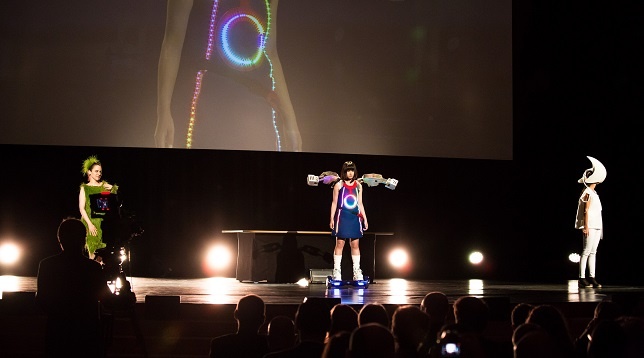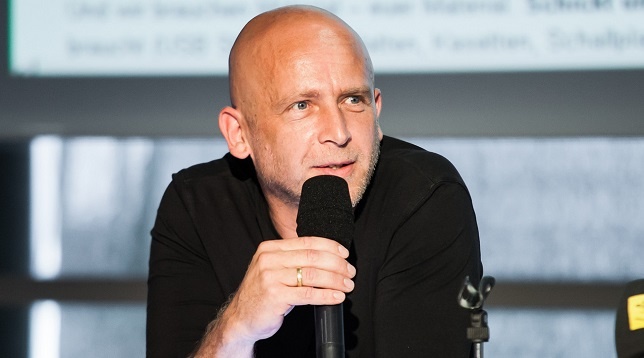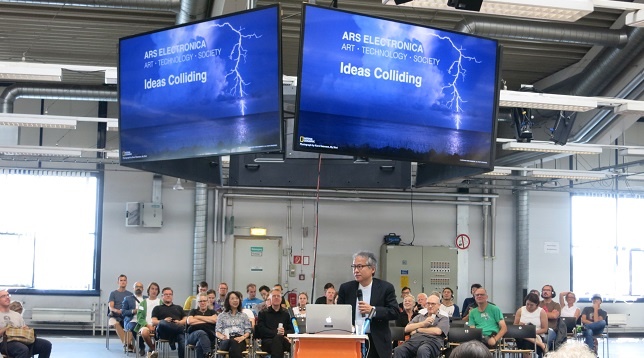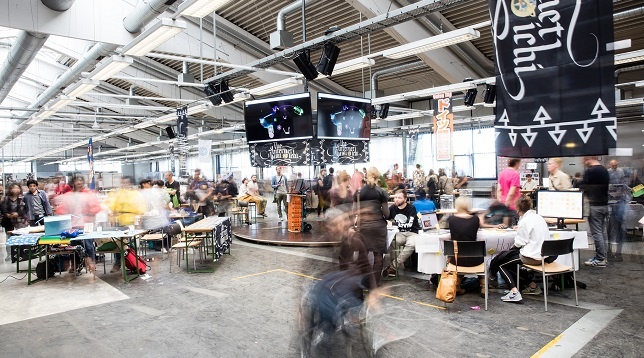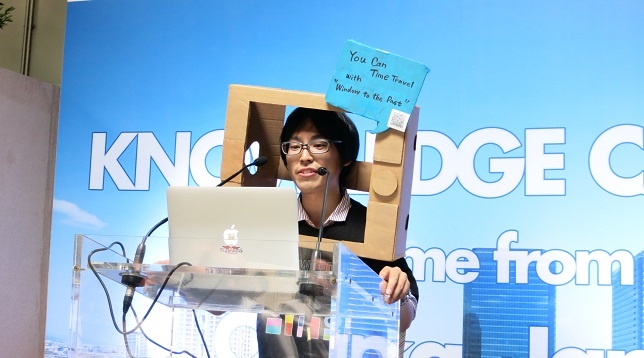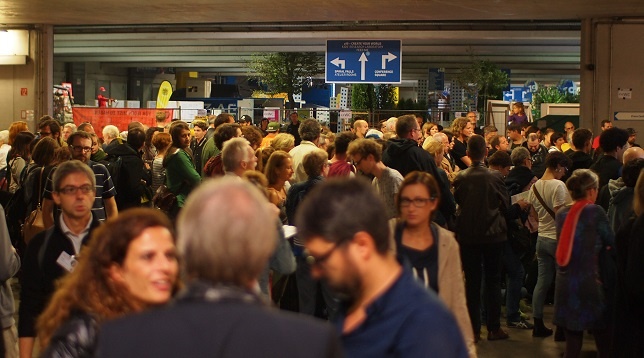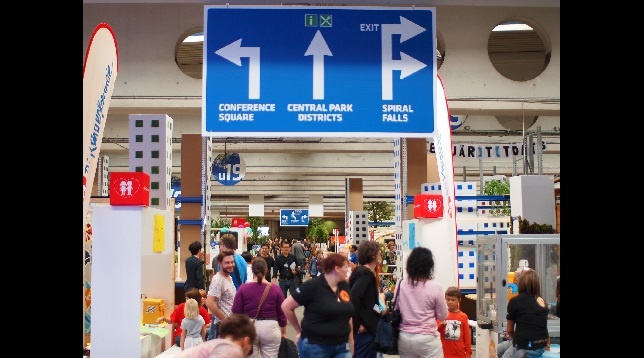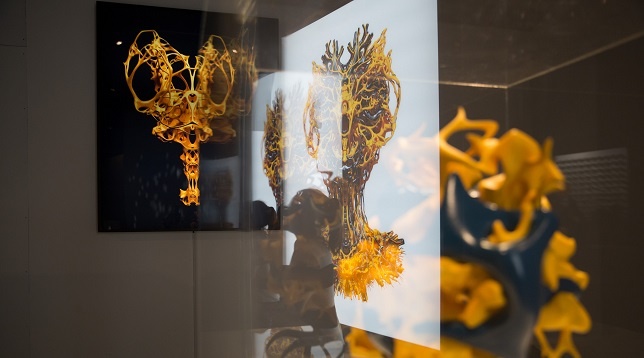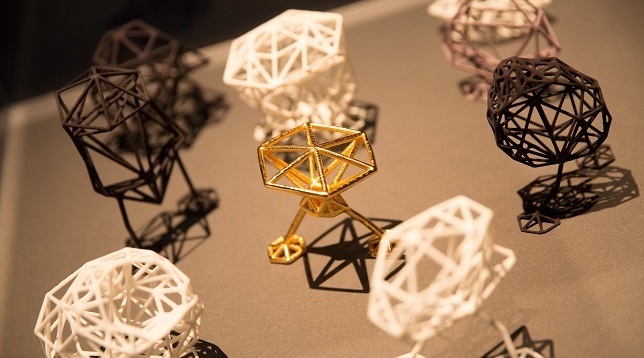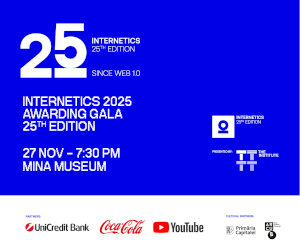The festival started in Linz, Austria, in 1979, featuring a line-up of 20 artists and scientists. The pilot project made history, being focused for more than 30 years on the nexus of Art, Technology and Society.
It became one of the most important meeting points for hundreds of artists, theoreticians, scientists, technologists & network nomads from all over the world.
The festival related Prix, “Golden Nica”, is the award to receive at the world’s most time-honored media arts competition.
It is all Ars Electronica: Festival, Prix, Archive, Export, Center, Future Lab, Solutions.
Lately artistic residencies at CERN & Paranal Observatory, offer the possibility to artists to develop outstanding projects together with scientists. Linz was included in the network UNESCO City of Media Arts, in 2014. The Festival received the EFFE Award that honors the Top 12 trend-setting European Festivals, in 2015. And last, but not least, Ars Electronica Futurelab, together with Intel has made it to the Guiness World Records book with the brand new “Drone 100” project.
As all initiatives of its kind, Ars Electronica has also gone through its share of changes and challenges in recent years. The 2015 edition called “POST CITY – Habitats for the 21st Century” mirrored it all in different ways.
Besides my particular fascination for Ars Electronica, at this year’s edition I had a continuous feeling of human touch in the process of bringing ideas to life. Since I consider crucial the human experience in the work processes, I invited Martin Honzik, Festival’s director, to a short discussion on how organizing a festival can become an art project in itself.
We live in times when it’s not enough for a festival to be the oldest, most respected and prestigious in order to go on successfully. What do you think keeps Ars Electronica different, inspiring and moving it further?
It is a definition of a new avant-garde. Ars Electronica developed itself, continuously looking for an avant-garde, to a Post-art festival and this I see as a natural process.
I meet so many artists who aim to no longer work in abstract creation levels. Instead, they want to participate in solving global problematics, having the potential to do so. A very good example is the work of Cesar Harada, a French- Japanese inventor, artist & entrepreneur, developing autonomous swimming drones to clean the sea.
We are looking for this new type of artists, who are willing to solve all kind of problems popping up in our society or to bring in new perspectives. Even if at first sight their projects have nothing to do with art, the artistic approach is hidden in the development process.
Another crucial thing is that Ars Electronica doesn’t focus on immanent art topics. That approach would have kept the festival in its own fences, feeding its own crowd.
I look at the festival topics along the years, especially after the digital revolution, and you will see they are related to burning questions, looking for answers, showing the need to address a broader public. On one hand, this led to a way larger popularity of the festival, giving wider, new perspective to art and its relation with science and society. On the other hand, opening this angle i had been also tricky, considered a disadvantage by the art immanent sector.
In the end, Ars Electronica has become a Post-art-Life-related Festival.
I would say that this year’s edition has been a different and special one. Besides the Festival theme “Post City” and the inspiring and challenging, in the same time, venue (the old Post building), there was particular community driven atmosphere all around. Could you share more about the experience of you and your team in making this edition happen?
The last two editions of the festival were completely different from the previous ones, as a consequence of the financial and political situation. The financial part was supported by many partners, co-producers of the Festival , who got together in a community to implement and showcase projects related to the theme. Instead of being a curated festival, Ars Electronica become more of a meeting point, organized playground, where communication and negotiation between partners were very important and the focus was kept on the process, apart from the results.
It’s been also a certain effect of decentralization in the work process. I felt like the Post-mayor of the Post City. Not one who shows the way, but one who asks where is the way and invites the participants to find it together. We had the chance to test in this new public quarter new rules of living in public.
In the end this approach has been constructive and had a very positive effect on the relations developed between people during the festival.
What about the Festival format? It was kind of a premiere, too, wasn’t it?
I really liked the festival format this year. It was organized as a real city set in the old Post Office building. It has been new and very challenging, there were more than 200 people taking care of complex logistics till the end of the festival. A couple of days after, the same team turned the festival location into a new temporary home for 700 refugees, arriving at the Linz train station, after we received an emergency call from the Red Cross.
The story of every edition starts with its end and this year we had the situation with the refugees. It’s been a once-in-a-life-time chance to immediately check theory with practice, not just showcasing it in a white cube, not just watching the action, but being the action. I’m still reflecting on this experience.
This is one of the situations when working on a festival can change your life. Sharing the same intense experiences brings people together and reinforces the community spirit.
Was this one the biggest festival edition? Being all in one place, it looked pretty concentrated and of a great impact.
The biggest Ars Electronica was the “Repair” one in 2010… and I can still feel it (laughs).
It was in Tabak Fabrik, we had the biggest amount of projects and it lasted for two weeks. More than 1000 people were working on it to happen, participants included.
I measure the success of making a festival by the feedback of the people I work with. I make sure to meet and communicate with every single team member and keep up the spirit and good will atmosphere. The feedback we receive from the guests about the festival team’s work is also important, but secondary. I mostly appreciate the time, which every team member invests in making the next edition come true. In the end we are all serving a wave. I see this process as a social sculpture and yes, it is an art project in itself to organize this festival.
In spite of all the efforts, there is always the risk of losing the natural gravity, not being able to keep track and control of all activities, when it all goes so big and broad. But it’s part of the experience. What I kind of regrets that, this time, I didn’t have the chance to get close enough to all projects and artists, as usually do.
There have been lots of discussions regarding the artistic quality of the projects presented at Ars Electronica. This is actually an issue related to Art, Technology & Science related art practices in general. How would you comment on this?
Since the begging, Ars Electornica Festival was not famous for the excellence of the artistic quality. That one is awarded at the Prix Ars Electronica and celebrated within the Cyber Arts exhibition, each year. The artistic quality is just part of the endeavor this Festival actually is. We talk here about experiments and experiences on social and global level and they are different every year. Here and there you can find impressive projects, but there are many other projects unrelated to art at all. The same is true at the Ars Electronica Center: it is not an art museum any longer. The artistic approach is used as a medium to open doors and give a new perspective on global, real things.
So, not keeping the focus only on artistic excellence, allows a Festival to keep its spirit alive, being flexible and changing all the time according to the needs of society?
Well, in a way, yes. It would, of course, be possible to fulfill the expectations of your question in focusing „just“ on the art world and context. That is a successful method, practiced for a long time. Sure that would work, but it would be more beneficial for the immanent art discourse than for the citizens and their needs. Opening topics of everybody to finally isolate them just for a small elite sounds for me a bit paradox. Our epicenter is not art, it is the citizen and his/her individual needs in the context of a rather fast changing world, dominated by tech and digitalization. Art in our context does not act as a good on a (art) market, the arts role here is being a translator, transformer, catalyst, membrane, door opener or simply the media coming with talent in explaining us the environment we created and the world we are living in. So, still there is a strong focus on art, as art is our source of existence and future, but we are also listening to our cultural order that has been telling us to ideally address and reach a broader public, (including the art world!) with the things we are doing. Responding to this „cultural order“, we naturally take advantage of aspects and samples coming from various other fields whether they are coming from science, technology, economy, industry and society.
Talking about the collaborations showcased at Ars Electronica, do you find collision or symbiosis, when it comes to art & science?
When we talk about collaboration between art & science, it’s all about changing the mindset of both parts. I can see the fascination in the eyes of the scientific partners, when they come to the festival and meet the artistic interpretation of their work, in one form or another. There is an intense exchange of vintage points, feelings and perceptions. Also, when artists are going for a residency to CERN or Paranal, there is a complex collaboration including ongoing constructive conflict, or let’s put it as continuous negotiation between the involved parts. This one is naturally arising usually and I guess, driving the world further.
And to finish on an artistic note: do you have any favorite project from this year’s Ars Electronica?
Yes, there was one work which got 10 of 10 points in my view: Nelo Akamatsu’s project called “Chijikinkutsu”, a sound installation inspired by the Japanese traditional gardens. The funny story behind is, that the artist originally submitted it at the Hybrid Art category, but the jury decided that it should be changed. The artist might have been really surprised to receive an award from a different category, than the one he submitted for. So, in the end it made it to the Golden Nica for Digital Music and Sound Art category.
A rarely globally-related, minimal, poetic experience, indeed!
During the last 3 editions, three projects signed by Romanian artists, were showcased at the exhibitions of Ars Electronica Festival:
“Feed me”, Noper & Saint Machine, 2015, “Hacking Meditation”, Mihaela Kavdanska & Cristian Iordache, 2014, “4th Skin”, Mihaela Kavdanska, Dolma Jover Agullo, Cristian Iordache, Randomform & KOTKI visuals, 2013.
The interactive art exhibition “Use at Your Own Risk” by Interface Culture Lab, part of Ars Electronica Festival 2013, was invited to Romania and displayed at Victoria Art Center & National Museum for Contemporary Art in March 2014. Co-oOrganized & co-produced by AVmotional Platform
Interview by: Mihaela Kavdanska/ KOTKI visuals
Special thanks to Andreea Voroneanu/ www.voro.space
It became one of the most important meeting points for hundreds of artists, theoreticians, scientists, technologists & network nomads from all over the world.
The festival related Prix, “Golden Nica”, is the award to receive at the world’s most time-honored media arts competition.
It is all Ars Electronica: Festival, Prix, Archive, Export, Center, Future Lab, Solutions.
Lately artistic residencies at CERN & Paranal Observatory, offer the possibility to artists to develop outstanding projects together with scientists. Linz was included in the network UNESCO City of Media Arts, in 2014. The Festival received the EFFE Award that honors the Top 12 trend-setting European Festivals, in 2015. And last, but not least, Ars Electronica Futurelab, together with Intel has made it to the Guiness World Records book with the brand new “Drone 100” project.
As all initiatives of its kind, Ars Electronica has also gone through its share of changes and challenges in recent years. The 2015 edition called “POST CITY – Habitats for the 21st Century” mirrored it all in different ways.
Besides my particular fascination for Ars Electronica, at this year’s edition I had a continuous feeling of human touch in the process of bringing ideas to life. Since I consider crucial the human experience in the work processes, I invited Martin Honzik, Festival’s director, to a short discussion on how organizing a festival can become an art project in itself.
We live in times when it’s not enough for a festival to be the oldest, most respected and prestigious in order to go on successfully. What do you think keeps Ars Electronica different, inspiring and moving it further?
It is a definition of a new avant-garde. Ars Electronica developed itself, continuously looking for an avant-garde, to a Post-art festival and this I see as a natural process.
I meet so many artists who aim to no longer work in abstract creation levels. Instead, they want to participate in solving global problematics, having the potential to do so. A very good example is the work of Cesar Harada, a French- Japanese inventor, artist & entrepreneur, developing autonomous swimming drones to clean the sea.
We are looking for this new type of artists, who are willing to solve all kind of problems popping up in our society or to bring in new perspectives. Even if at first sight their projects have nothing to do with art, the artistic approach is hidden in the development process.
Another crucial thing is that Ars Electronica doesn’t focus on immanent art topics. That approach would have kept the festival in its own fences, feeding its own crowd.
I look at the festival topics along the years, especially after the digital revolution, and you will see they are related to burning questions, looking for answers, showing the need to address a broader public. On one hand, this led to a way larger popularity of the festival, giving wider, new perspective to art and its relation with science and society. On the other hand, opening this angle i had been also tricky, considered a disadvantage by the art immanent sector.
In the end, Ars Electronica has become a Post-art-Life-related Festival.
I would say that this year’s edition has been a different and special one. Besides the Festival theme “Post City” and the inspiring and challenging, in the same time, venue (the old Post building), there was particular community driven atmosphere all around. Could you share more about the experience of you and your team in making this edition happen?
The last two editions of the festival were completely different from the previous ones, as a consequence of the financial and political situation. The financial part was supported by many partners, co-producers of the Festival , who got together in a community to implement and showcase projects related to the theme. Instead of being a curated festival, Ars Electronica become more of a meeting point, organized playground, where communication and negotiation between partners were very important and the focus was kept on the process, apart from the results.
It’s been also a certain effect of decentralization in the work process. I felt like the Post-mayor of the Post City. Not one who shows the way, but one who asks where is the way and invites the participants to find it together. We had the chance to test in this new public quarter new rules of living in public.
In the end this approach has been constructive and had a very positive effect on the relations developed between people during the festival.
What about the Festival format? It was kind of a premiere, too, wasn’t it?
I really liked the festival format this year. It was organized as a real city set in the old Post Office building. It has been new and very challenging, there were more than 200 people taking care of complex logistics till the end of the festival. A couple of days after, the same team turned the festival location into a new temporary home for 700 refugees, arriving at the Linz train station, after we received an emergency call from the Red Cross.
The story of every edition starts with its end and this year we had the situation with the refugees. It’s been a once-in-a-life-time chance to immediately check theory with practice, not just showcasing it in a white cube, not just watching the action, but being the action. I’m still reflecting on this experience.
This is one of the situations when working on a festival can change your life. Sharing the same intense experiences brings people together and reinforces the community spirit.
Was this one the biggest festival edition? Being all in one place, it looked pretty concentrated and of a great impact.
The biggest Ars Electronica was the “Repair” one in 2010… and I can still feel it (laughs).
It was in Tabak Fabrik, we had the biggest amount of projects and it lasted for two weeks. More than 1000 people were working on it to happen, participants included.
I measure the success of making a festival by the feedback of the people I work with. I make sure to meet and communicate with every single team member and keep up the spirit and good will atmosphere. The feedback we receive from the guests about the festival team’s work is also important, but secondary. I mostly appreciate the time, which every team member invests in making the next edition come true. In the end we are all serving a wave. I see this process as a social sculpture and yes, it is an art project in itself to organize this festival.
In spite of all the efforts, there is always the risk of losing the natural gravity, not being able to keep track and control of all activities, when it all goes so big and broad. But it’s part of the experience. What I kind of regrets that, this time, I didn’t have the chance to get close enough to all projects and artists, as usually do.
There have been lots of discussions regarding the artistic quality of the projects presented at Ars Electronica. This is actually an issue related to Art, Technology & Science related art practices in general. How would you comment on this?
Since the begging, Ars Electornica Festival was not famous for the excellence of the artistic quality. That one is awarded at the Prix Ars Electronica and celebrated within the Cyber Arts exhibition, each year. The artistic quality is just part of the endeavor this Festival actually is. We talk here about experiments and experiences on social and global level and they are different every year. Here and there you can find impressive projects, but there are many other projects unrelated to art at all. The same is true at the Ars Electronica Center: it is not an art museum any longer. The artistic approach is used as a medium to open doors and give a new perspective on global, real things.
So, not keeping the focus only on artistic excellence, allows a Festival to keep its spirit alive, being flexible and changing all the time according to the needs of society?
Well, in a way, yes. It would, of course, be possible to fulfill the expectations of your question in focusing „just“ on the art world and context. That is a successful method, practiced for a long time. Sure that would work, but it would be more beneficial for the immanent art discourse than for the citizens and their needs. Opening topics of everybody to finally isolate them just for a small elite sounds for me a bit paradox. Our epicenter is not art, it is the citizen and his/her individual needs in the context of a rather fast changing world, dominated by tech and digitalization. Art in our context does not act as a good on a (art) market, the arts role here is being a translator, transformer, catalyst, membrane, door opener or simply the media coming with talent in explaining us the environment we created and the world we are living in. So, still there is a strong focus on art, as art is our source of existence and future, but we are also listening to our cultural order that has been telling us to ideally address and reach a broader public, (including the art world!) with the things we are doing. Responding to this „cultural order“, we naturally take advantage of aspects and samples coming from various other fields whether they are coming from science, technology, economy, industry and society.
Talking about the collaborations showcased at Ars Electronica, do you find collision or symbiosis, when it comes to art & science?
When we talk about collaboration between art & science, it’s all about changing the mindset of both parts. I can see the fascination in the eyes of the scientific partners, when they come to the festival and meet the artistic interpretation of their work, in one form or another. There is an intense exchange of vintage points, feelings and perceptions. Also, when artists are going for a residency to CERN or Paranal, there is a complex collaboration including ongoing constructive conflict, or let’s put it as continuous negotiation between the involved parts. This one is naturally arising usually and I guess, driving the world further.
And to finish on an artistic note: do you have any favorite project from this year’s Ars Electronica?
Yes, there was one work which got 10 of 10 points in my view: Nelo Akamatsu’s project called “Chijikinkutsu”, a sound installation inspired by the Japanese traditional gardens. The funny story behind is, that the artist originally submitted it at the Hybrid Art category, but the jury decided that it should be changed. The artist might have been really surprised to receive an award from a different category, than the one he submitted for. So, in the end it made it to the Golden Nica for Digital Music and Sound Art category.
A rarely globally-related, minimal, poetic experience, indeed!
During the last 3 editions, three projects signed by Romanian artists, were showcased at the exhibitions of Ars Electronica Festival:
“Feed me”, Noper & Saint Machine, 2015, “Hacking Meditation”, Mihaela Kavdanska & Cristian Iordache, 2014, “4th Skin”, Mihaela Kavdanska, Dolma Jover Agullo, Cristian Iordache, Randomform & KOTKI visuals, 2013.
The interactive art exhibition “Use at Your Own Risk” by Interface Culture Lab, part of Ars Electronica Festival 2013, was invited to Romania and displayed at Victoria Art Center & National Museum for Contemporary Art in March 2014. Co-oOrganized & co-produced by AVmotional Platform
Interview by: Mihaela Kavdanska/ KOTKI visuals
Special thanks to Andreea Voroneanu/ www.voro.space
















